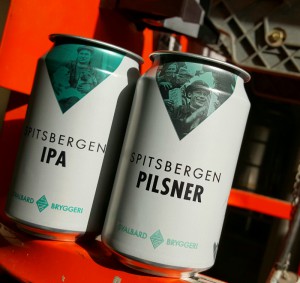
Longyearbyen, Norway – Svalbard Brewery — the world’s northernmost brewery — has become Cask’s first Norwegian micro-canning craft brewery.
Years in the making, Svalbard Brewery is located in the remote town of Longyearbyen (population 2,400) on Spitsbergen Island in Norway’s Svalbard Islands archipelago. The Arctic Ocean islands are home to an estimated 3,500 polar bears, and the brewery is just over 800 miles from the North Pole.
To make his brewery a reality, founder Robert Johansen had to overcome numerous obstacles due to the brewery’s extreme northern location. He also had to complete a lengthy campaign to change longstanding laws that prohibited brewing in the region.
The brewery is now open and launching its first packaged beers in cans filled and seamed on Cask Brewing System’s Automatic Canning System (ACS).
“Robert is a true brewing pioneer,” says Cask founder Peter Love. “He is defying his country’s traditional practices and literally rewriting the rules for brewers there. He joins a large group of innovative craft brewers who are having great success thanks to their unconventional thinking and our micro-canning machines.”
Svalbard’s founders cite the many benefits of aluminum cans and Cask Brewing System’s pioneering reputation as reasons for opening with cans instead of bottles.
“Cans,” says co-founder Anne Grete Johansen, “are lightweight, easier to store and easier to transport. They are perfect for trips in the wilderness, which are very common here among locals and tourists coming to see polar bears, glaciers and the landscape. They are also better for the environment as cans are recycled here in Norway and are worth 1 NOK for each can someone returns.”
She and her husband chose Cask for several reasons. “We learned about Cask on the Web while doing research,” she says. “We discovered that they created this concept of micro-canned craft beer and they have a long history of helping small brewers like us. We also got some good references about Cask from some peers in Sweden.”
Svalbard’s first canned beers are Spitsbergen Pilsner, Spitsbergen IPA and Spitsbergen Pale Ale. The beers are available for purchase at Longyearbyen bars, restaurants and the town’s one beer store.
Johansen hopes to have her micro-canned beers in Norway’s government-run system in November, once they are approved for sale and the country’s recycling program. The beers are made with melted water from the region’s surrounding glaciers.
“Svalbard’s embracing of our equipment and cans,” Love says, “highlights the advantages we’ve been touting since we invented micro-canning. With the brewery’s remote location, reduced shipping and packaging costs are especially crucial. Recycling is just as important for Svalbard’s business as it is for the local environment. Our canning gear and cans make all of those things possible for the brewery.
“Canned craft beer is the hottest craft beer package in North America,” Love says. “Someday that will be the case in Norway.”
Cask created the micro-canned concept while working with brew-on-premise homebrewing operations it supplied in Canada, the US and Australia. Cask placed its first canning gear in those BOPS in 1999.
In 2002 Cask sold its first machine (a table-top machine that seamed one can at a time) to a craft brewer, Oskar Blues Brewery & Pub in Colorado, USA. The tiny brewpub was the first US microbrewer to brew and can its own beer. Its cans-only focus helped make it one of craft beer’s fastest-growing breweries, with production quickly rising from 700 barrels/year to over 149,000 barrels/year in 12 years.
Sales of US canned sixpacks last year were up 97% compared to 14% growth of bottles.
“Our canning systems,” Love says, “have helped micro and craft breweries around the world enter the packaged-beer segment and quickly grow their businesses. We’re very proud of that.”
Cask’s manual, semi-automated and automated canning systems are now used by over 500 small breweries, wineries, cider and drinks makers in over 40 nations.
The machines require as little as 16 square feet of space. They also provide extremely low levels of dissolved oxygen (15-20 parts per billion) that extend a beer’s shelf life and flavor.